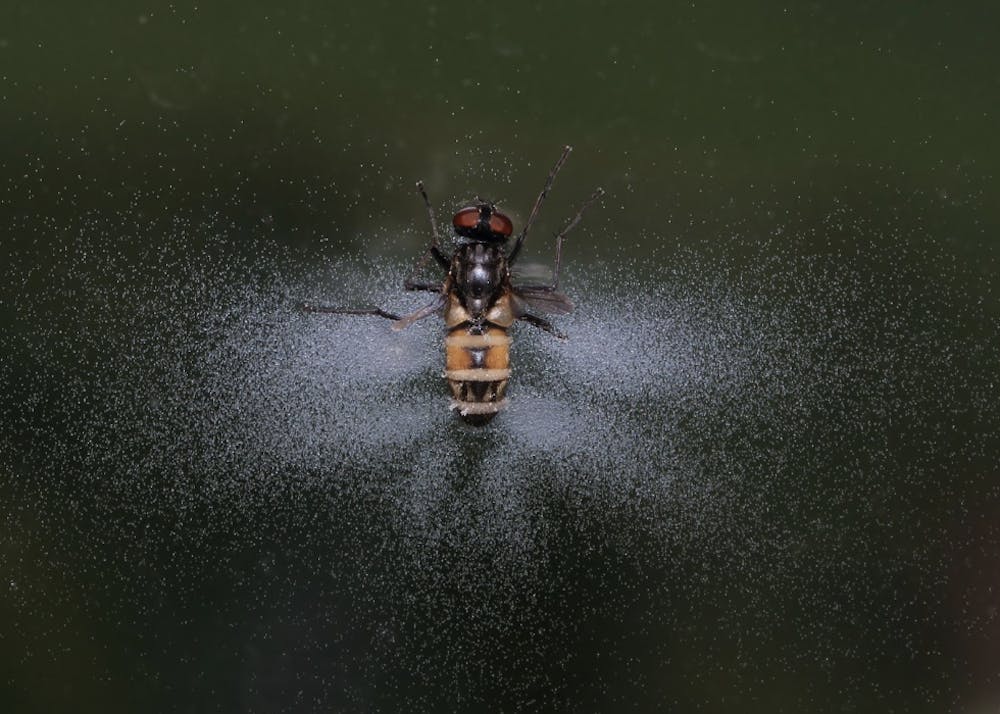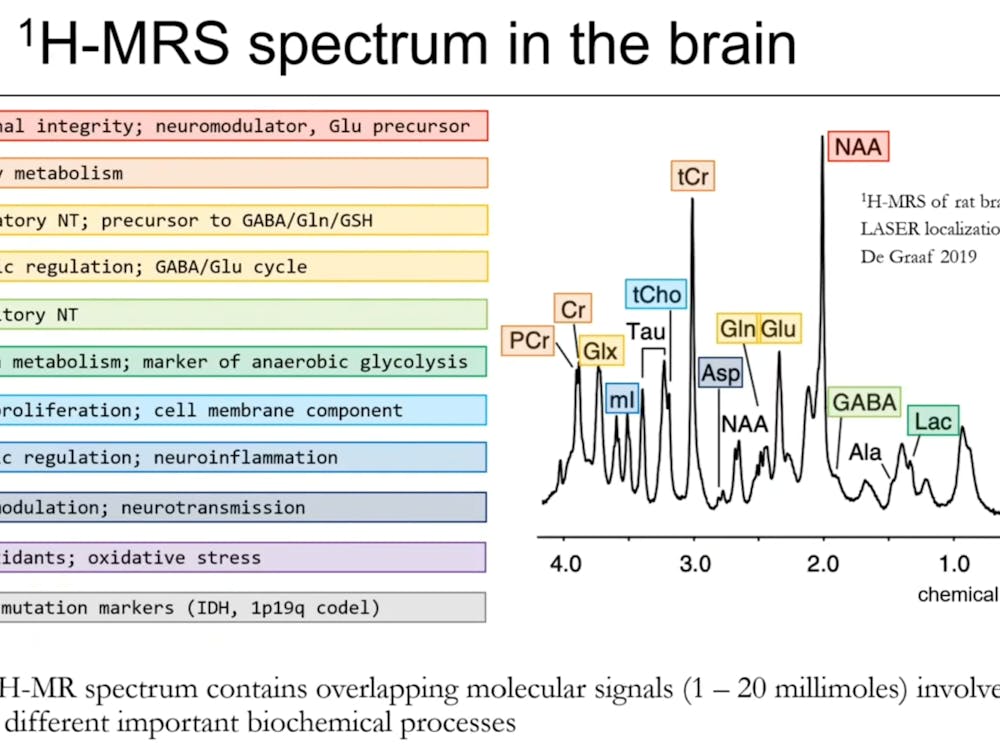Carolyn Elya gave a talk titled, "The Last of (Fung)us: Mechanisms of Fruit Fly Behavioral Manipulation by the Killer Fungus Entomophthora muscae" on Feb. 13 as part of the Department of Biology Seminar Series. Elya, an an assistant professor in the Department of Molecular and Cellular Biology at Harvard University, leads a lab focused on elucidating how parasites manipulate the behavior of their hosts.
Specifically, she is interested in flies that climb up to an elevated surface, strike a pose with outstretched wings and die at sunset. The reason behind this strange behavior is the aptly named Entomophthora muscae fungus. From its Greek roots, Entomo means insect and plethora means destruction — making E. muscae the insect-destroying genus that targets flies.
Before Elya’s work, E. muscae had been difficult to study in the lab, limiting researchers’ ability to investigate its life cycle. In graduate school at the University of California, Berkeley, Elya developed a novel system to study E. muscae interactions with fruit flies.
Three factors converged, enabling Elya’s to harvest these infected flies in the laboratory. First, she set fly traps in her backyard for an unrelated project on the gut microbiome. A spout of luck ushered fuzzy-looking flies into her baits in 2015. Lastly, her interest in parasites allowed her to identify the discovery.
“When I saw the [infected fruit flies], because of my interest in these systems, I knew exactly what it was. I saw it as a sign from the science gods that I needed to get this into the lab,” she explained. “And now we have in the lab this robust, beautiful zombie system. We can grow zombies on demand.”
Armed with a system to study E. muscae, she founded her own lab to investigate the progression of this fungal infection, including how the host is manipulated to promote fungal dispersal.
The release of fungal spores from an infected fly begins what Elya calls the cycle of death. Spores travel through the air and land on an unsuspecting fly’s skin and infect the fly.
“Those propagules or spores will land on the skin of a susceptible host. That propagule will then proceed to punch a hole through the cuticle and insert a germ tube — which I like to refer to as a crazy straw — which it uses to shuttle a fungal cell into the fly's open circulatory system,” she said.
E. muscae feeds on the fly’s body fat while avoiding vital organs, allowing the host to remain alive. Approximately two days later, the fungus makes its way to the fly’s brain. Four to seven days after infection, the fly’s body fat becomes depleted, which may signal the fungus to begin prepping to leave its host. At this stage, behavioral manipulation comes into play.
On the day of their death, flies climb up a tall object in their environment such as a plant — a behavior called summiting. Once reaching sufficient elevation, they extend a mouthpart called the proboscis. A fungal secretion causes the proboscis to stick to the surface the fly is standing on, trapping it in place. As death approaches, the sun begins sinking. The fly’s last act is to raise its wings away from its body — giving the fungal spores an unobscured path from which to shoot out from the fly’s abdomen — and die.
From the fly’s elevated position, the spores travel through the air and land on a new fly’s skin, beginning the process all over again.
In explaining the cycle of death, Elya emphasized her curiosity regarding the mechanism driving flies to die consistently at sunset. How is this system keeping track of time?
To find an answer, Elya tested whether light conditions impact when the flies die. Her lab exposed flies to light and dark cycles which were modified to vary from natural conditions. Yet, even in complete darkness, death still took place at sunset. This finding indicates that death might not be driven by environmental conditions such as light cycles, but by an internal timekeeper.
If that is the case, Elya wondered, is the timekeeping machinery in the fungus or the fly?
To understand this question, she first investigated whether a fly’s circadian system is necessary for E. muscae to induce death at sunset. Elya exposed flies that exhibited genetically modified or nonfunctioning circadian rhythms to multiple environmental conditions, including complete darkness. If their internal clock is timing their death, flies with a broken circadian rhythm shouldn’t have the necessary machinery to die at sunset.
Her results showed the opposite effect.
“Regardless of the genotype of these flies, by large, the flies are dying at the same time, indicating that the [internal] fly clock is not important for dictating the time of death,” she said.
Then, Elya investigated whether the fungus itself acts as the internal timekeeper, inducing death at sunset.
“We want to sort E. muscae’s ability to keep time independent of anything that the fly has to offer. In the situation where we've mutated various photoreceptors, it is still possible that we still have the clock [gene] running, and the fungus is somehow feeding off of that, or [is there] some other cue that we haven't accounted for that the fungus is eavesdropping on in order to determine what time it is,” she questioned.
The lab ensured specificity in experiments by growing the fungus in vitro, meaning it was grown separately from the fly. This E. muscae was exposed to normal light-dark cycles as well as complete darkness.
Consistent with our human circadian rhythms, we are more active at certain times of the day. If the fungus has its own internal timekeeping mechanism, its activity should also be rhythmic at consistent times, even if you remove environmental cues. To confirm this hypothesis, Elya’s lab analyzed when E. muscae turned DNA into mRNA, finding that the fungi’s transcription rhythms were cyclical in both normal and modified light conditions.
This suggests that the fungi have circadian processes and may possess the timekeeping machinery necessary to kill the flies at sunset.
Yet, open questions remain. Elya’s lab has observed divergences in the circadian rhythm of flies that survive fungal infection and those that don’t.
“How, in this battle of a system with two clocks, are you able to get one clock to emerge triumphant?” she wondered.
Beyond unveiling the molecular mechanisms of how E. muscae manipulates its host, the fungal and fly system help answer larger questions about the natural world.
In an interview with The News-Letter, freshman Ava Li discussed the potential practical uses of the system.
“She mentioned how you could use the spores as a potential pesticide,” Li stated. “A lot of times, spores don't really have a very positive connotation, but, when it comes to getting rid of a pest, it was actually a really interesting application.”
Elya noted that pecies of the Entomophthora genus have evolved to target their specific hosts. If difficulties with the implementation of these system are overcome, the fungus could be used to target specific pests while leaving others untouched, unlike chemical pesticides which often indiscriminately target both beneficial and harmful insects.
On a broader scale, Elya explained how parasite and host interactions are a strong avenue through which to uncover the mechanisms underlying animal behavior.
“Parasites have something fundamental in common, which is that they've all basically cracked the code in terms of figuring out how to manipulate animal behavior,” she added. “Over evolutionary time, they figured out the proverbial dials to turn and the buttons to push in order to drive their hosts to do exactly what they need them to do in order for their own fitness.”
At the end of her talk, Dr. Carolyn thanked everyone who contributed to and supported her work. And, as applause filled the room, she smiled, giving one last thank you to the fungus for showing up in her backyard.
“If we can understand how these parasites are able to drive behavior among animal hosts, then I think we have a huge opportunity to learn about how behaviors are included and generated and how we might be able to modify our own behaviors for maybe not-so nefarious purposes,” she concluded.





